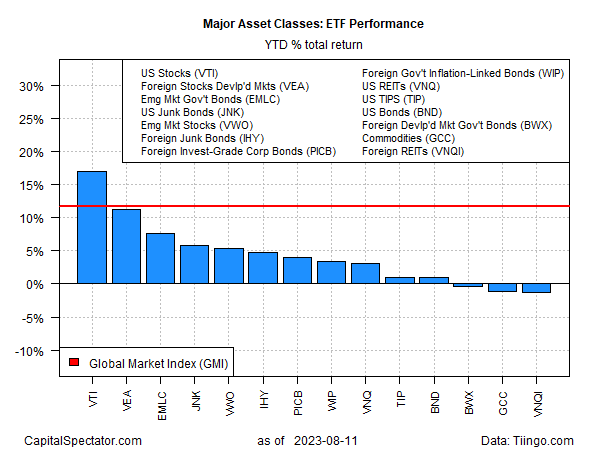Global Rally Stalls, Pulling More Markets Into Red For 2023
Most of the world’s markets are still posting sizable gains year to date, but the recent selling has claimed another victim for the loss column. As of Friday’s close, three of the 14 slices of the major asset classes are now underwater this year, based on ETF proxies through through Friday, Aug. 11. Two weeks ago, all the major asset classes were enjoying gains in 2023.

It’s unclear if the current pullback is a healthy correction that lays the groundwork for even greater heights or the start of deeper trouble that will take a toll on markets in the months ahead.
US stocks (VTI) are still far ahead in the horse race with a 16.9% rise so far in 2023. The weakest year-to-date performer: real estate ex-US (VNQI), which has shed a mild 1.3%.
A key factor that investors are focusing on is China’s economic slowdown. In particular, is the diminished outlook for the world’s second-largest economy fully priced in to world markets?
“Before the pandemic, China was growing at about 6%, and now it’s struggling to recover,” says David Dollar, a senior fellow at the Brookings Institute’s China center. “Consumption really didn’t hold up coming out of the lockdown. The main components of GDP on the demand side — consumption, investment, net exports — they all have serious problems right now.”
Larry Hu, Hong Kong-based chief China economist for Macquarie predicts: “The slowdown in China is definitely going to weigh on the global economic outlook.”
One way to monitor the China effect, for good or ill, in the equities markets is comparing a broad measure of emerging markets stocks (EEM), inclusive of China, to its counterpart that removes the country’s shares (EMXC) and world shares overall (VT). For additional context, a China equities ETF (MCHI) is shown in the year-to-date chart below.
The main takeaway: the China effect is only just starting to bite in stock prices and there will be knock-on effects for large US firms with operations in the country, The Wall Street Journal reports:
China’s deepening economic slump is damaging the fortunes of big American companies deeply rooted there, with some growing increasingly pessimistic that the country’s long-awaited postpandemic boom will materialize.
Companies embedded in China’s ailing manufacturing, construction and export industries are reporting weaker sales. In some cases, they are warning of further trouble to come as growth grinds to a near halt and economic readings are dour.
The good news: the US economy still looks resilient and, to an extent, will offset China’s weakness. US output picked up in the second quarter, based on GDP. The Atlanta Fed’s latest nowcast for Q3 indicates a further acceleration in growth, based on the regional Fed bank’s GDPNow model.
Nonetheless, the outlook for the global economy looks increasingly uncertain as the extent of China’s slowdown is only just coming into view.
“The weak July credit data suggest the downward spiral of [China’s] property sector continues, and worsening geopolitical tensions add to the uncertainty,” advises Lu Ting, chief China economist at Nomura, and a team said in a report on Friday. “In Japan during the 1990s, corporates might have paid down their debt to improve their chances of survival, but in today’s China, corporates and households are cutting their borrowing due to a lack of confidence (and trust).”
The bottom line: these are still early days for assessing China’s slowdown and what it means for the global economy and markets.
More By This Author:
10-Year US Treasury Yield ‘Fair Value’ Estimate - Friday, Aug. 11
Foreign Bonds Lead US Fixed Income So Far In 2023
Markets Continue To Signal A Risk-On Bias Prevails
Disclosure: None.





